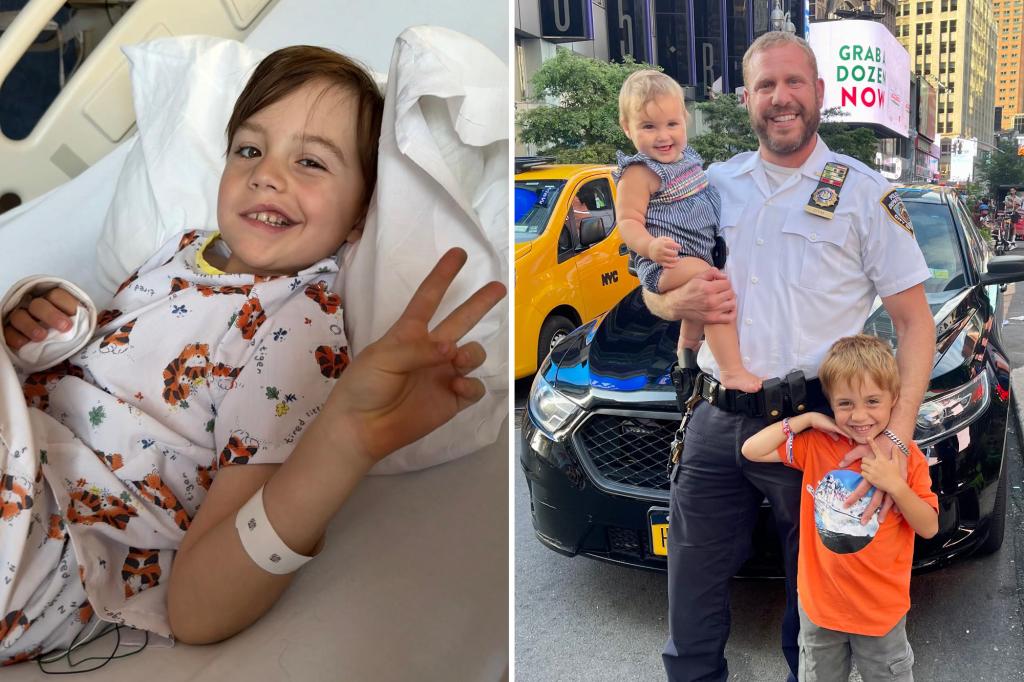A Hero’s Journey: The Heartbreaking Battle of an 8-Year-Old Against Rare Brain Cancer
In a quiet Long Island neighborhood, 8-year-old Liam O’Connor, the son of a retired NYPD officer, wages a courageous fight against diffuse intrinsic pontine glioma (DIPG), an aggressive and rare pediatric brain cancer. Diagnosed in January 2023, Liam’s journey has become a beacon of hope and a stark reminder of the urgent need for research into childhood cancers. His family’s emotional struggle highlights both the resilience of young patients and the devastating impact of underfunded medical conditions.
The Diagnosis That Changed Everything
Liam’s symptoms began with subtle changes—frequent headaches, balance issues, and a slight facial droop that his parents initially attributed to childhood fatigue. By the time doctors at Cohen Children’s Medical Center identified the 3.5 cm tumor in his brainstem, the DIPG had already progressed to an advanced stage. “It was like the floor disappeared beneath us,” said his father, Patrick O’Connor, who spent 22 years protecting others as a police officer but now faces an enemy he can’t arrest.
DIPG accounts for just 10-15% of all pediatric brain tumors but carries a grim prognosis:
- Median survival of 9-12 months post-diagnosis
- 5-year survival rate below 1%
- No FDA-approved treatments specifically for DIPG
The Emotional Toll on Families
Pediatric oncologist Dr. Sarah Chen explains: “What makes DIPG particularly cruel is its location. The tumor intertwines with critical brainstem structures, making surgical removal impossible. Families face impossible choices between quality of life and experimental treatments.” The O’Connors have pursued both—radiation temporarily shrank Liam’s tumor, but they’ve also embraced moments of normalcy, like his Make-A-Wish trip to meet Spider-Man.
Liam’s mother, Maria, describes their dual reality: “One moment you’re cheering because he ate a full meal, the next you’re researching clinical trials at 3 AM. The emotional whiplash never stops.” Their experience mirrors that of approximately 300 U.S. families receiving DIPG diagnoses annually—a number that hasn’t improved in decades due to research funding disparities.
The Science Behind the Struggle
Unlike adult cancers that benefit from decades of research, pediatric cancers receive less than 4% of the National Cancer Institute’s budget. DIPG presents unique challenges:
- The blood-brain barrier blocks most chemotherapy drugs
- Tumor samples are difficult to obtain for study
- Genetic mutations differ from adult brain cancers
However, emerging technologies bring cautious optimism. CAR-T cell therapy and targeted drug delivery systems show promise in early trials. “We’re finally understanding DIPG at the molecular level,” says Dr. Chen. “But progress needs funding—these kids don’t have time to wait.”
A Community Rallies Behind Their Hero
The O’Connors’ police and neighborhood communities have mobilized support through:
- Fundraisers generating over $200,000 for research
- A social media campaign #LiamsFight with 50,000+ engagements
- Advocacy for the Childhood Cancer STAR Act
Retired Officer O’Connor reflects: “After 9/11, we saw the worst bring out the best in people. Now, watching strangers donate and scientists work tirelessly—it’s that same spirit.” Meanwhile, Liam continues treatment with remarkable grace, telling nurses, “I’m not scared because I have my army.”
What the Future Holds for Pediatric Cancer Research
While Liam’s battle continues, his story has amplified calls for change. Recent developments suggest potential breakthroughs:
- The DIPG Awareness Resolution introduced in Congress (2023)
- 22 active clinical trials targeting DIPG pathways
- Increased collaboration between research institutions
Nonetheless, experts emphasize that without sustained funding and public awareness, promising research may stall. “Every story like Liam’s should be a wake-up call,” urges Dr. Chen. “These children deserve more than just prayers—they deserve a fighting chance.”
For those moved by Liam’s journey, consider supporting organizations like the ChadTough Foundation or contacting legislators to prioritize childhood cancer funding. As the O’Connors have learned, hope in the face of DIPG requires not just courage from patients, but commitment from all of us.
See more WebMD Network



